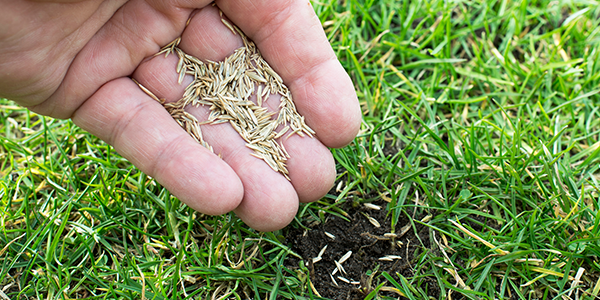Fall is the best time to seed or overseed your lawn because it presents the most ideal conditions for seed germination. These conditions include adequate soil moisture, light, and most importantly, temperature. Learn how and when to seed a new lawn and the different grass seed options that do well in Northeast Ohio.
When to Seed a New Lawn
The fall often arrives with a mix of cool air and moderately warm soil temperatures that create the perfect conditions for grass seeds to thrive. The warm soil supports moisture and as a result, your seeds won't dry out as quickly when compared to months with hotter soil temperatures such as summer or spring.
An added benefit to seeding your lawn in the fall is that weeds also start to slow down. You can easily curtail their growth during this time by turning the soil, handpicking any weed remnants, and replacing it with lush, green grass by seeding your lawn.

How to Seed a New Lawn
There are a few essential steps you need to take to give your lawn seeds the most suitable environment for them to thrive. First, ensure that your lawn is tilled and turned to aerate your soil. You should also remove any weeds you find and add some organic matter to the soil to enrichen it such as topsoil, compost, and peat.
Next, you should rake the soil to make it level and use a rotary or drop-style seed spreader to spread the grass seeds evenly. You should pass over the lawn at least twice to ensure even coverage and rake once more to cover the seeds lightly with soil. We also recommend pressing the seeds to the ground and mulching the area with straw to protect the seed.
To ensure their growth, water the area thoroughly for 15 to 20 days so the seeds can germinate. Once the grass is established, water less frequently and mow when the grass reaches about 3 inches in height.
Overseed Your Lawn in the Fall
Overseeding your lawn is the perfect solution for already established lawns that have patches that need reinforcement. To successfully overseed, aerate any areas you plan to seed by turning the soil and boosting the soil's nutrients with compost. When you aerate your soil, you are creating small pockets for the seeds to fall into and germinate at a faster rate. Add your seeds to the aerated soil and water it thoroughly once a day until your new grass grows.
Types of Grass Seed for Northeast Ohio
Using the correct kind of grass seed is integral for your lawn's success. If you are not in Northeast Ohio, use a zone map to research what kind of grass would thrive in your climate. Northeast Ohio is in Zone 6B and is a cool-season grass zone. The types of grasses that do well in this zone include:
- Ryegrass
- Buffalo Grass
- Creeping Red Fescue
- Tall Fescue
- Bluegrass
- Bentgrass
Buffalo grass is a native grass and is incredibly adaptable and easy to establish. You can also use mixed seeds such as a blend of bluegrass and ryegrass to benefit from different textures and attributes.
Get Everything You Need to Seed Your Lawn with Kurtz Bros., Inc.
To purchase organic materials to help fortify your soil to seed your lawn, Kurtz Bros., Inc. has it all! We have an array of high-quality grass seeds and organic soil, compost, and peat. Contact us today, our associates would be happy to assist you.
